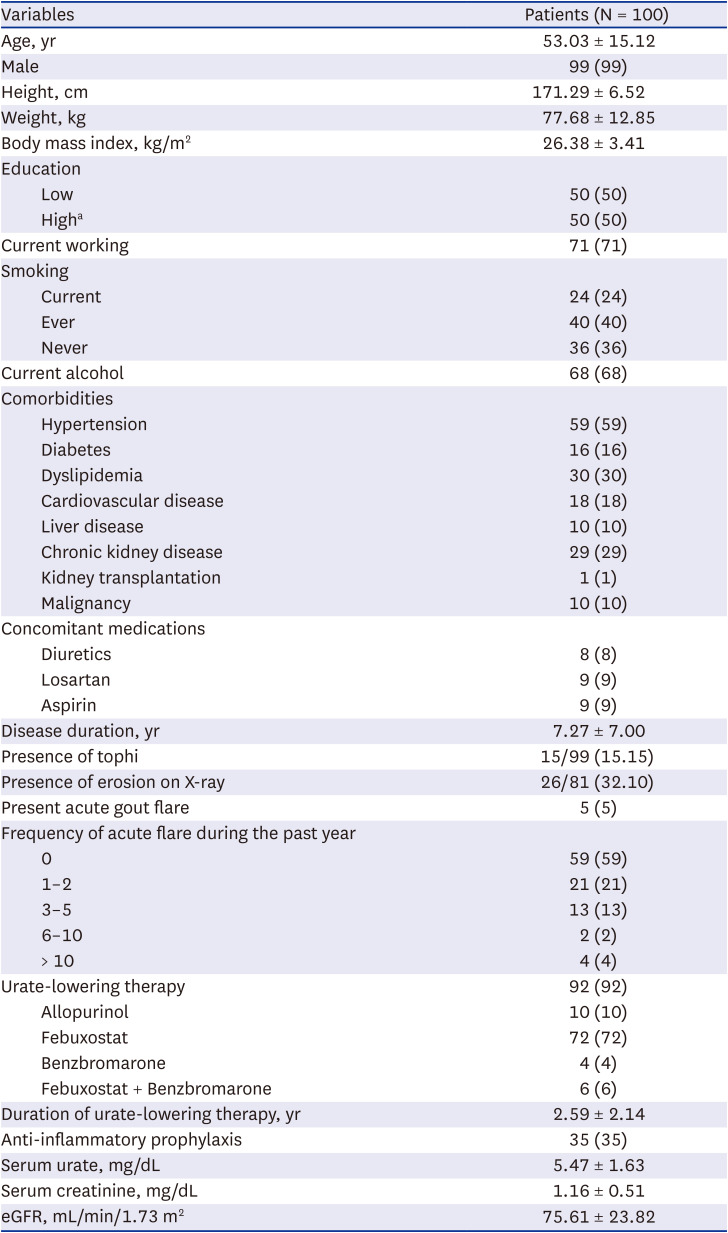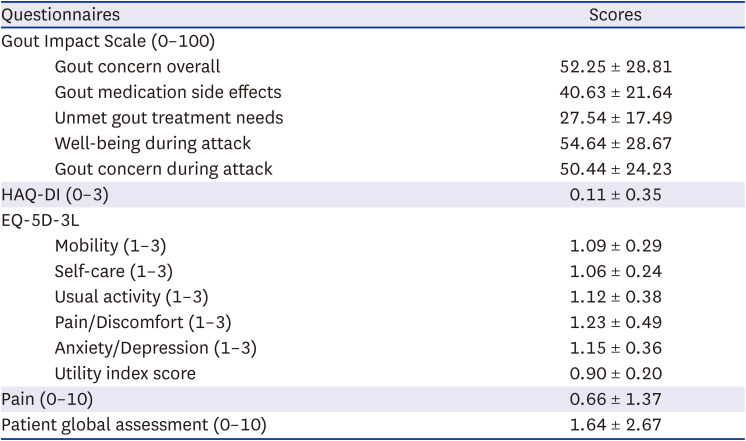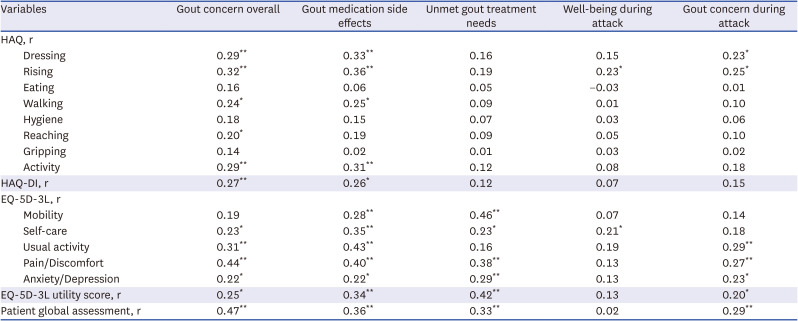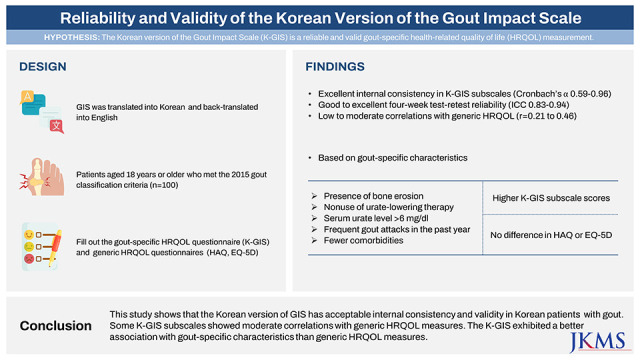1. Roddy E, Doherty M. Epidemiology of gout. Arthritis Res Ther. 2010; 12(6):223. PMID:
21205285.
2. Sundy JS, Baraf HS, Yood RA, Edwards NL, Gutierrez-Urena SR, Treadwell EL, et al. Efficacy and tolerability of pegloticase for the treatment of chronic gout in patients refractory to conventional treatment: two randomized controlled trials. JAMA. 2011; 306(7):711–720. PMID:
21846852.

3. Doherty M, Jenkins W, Richardson H, Sarmanova A, Abhishek A, Ashton D, et al. Efficacy and cost-effectiveness of nurse-led care involving education and engagement of patients and a treat-to-target urate-lowering strategy versus usual care for gout: a randomised controlled trial. Lancet. 2018; 392(10156):1403–1412. PMID:
30343856.

4. Aung T, Myung G, FitzGerald JD. Treatment approaches and adherence to urate-lowering therapy for patients with gout. Patient Prefer Adherence. 2017; 11:795–800. PMID:
28458524.

5. Singh JA, Taylor WJ, Simon LS, Khanna PP, Stamp LK, McQueen FM, et al. Patient-reported outcomes in chronic gout: a report from OMERACT 10. J Rheumatol. 2011; 38(7):1452–1457. PMID:
21724715.

6. Fries JF, Spitz P, Kraines RG, Holman HR. Measurement of patient outcome in arthritis. Arthritis Rheum. 1980; 23(2):137–145. PMID:
7362664.

7. Mazur W, Kupiainen H, Pitkäniemi J, Kilpeläinen M, Sintonen H, Lindqvist A, et al. Comparison between the disease-specific Airways Questionnaire 20 and the generic 15D instruments in COPD. Health Qual Life Outcomes. 2011; 9(1):4. PMID:
21235818.

8. Roddy E, Zhang W, Doherty M. Is gout associated with reduced quality of life? A case-control study. Rheumatology (Oxford). 2007; 46(9):1441–1444. PMID:
17586863.

9. Lee SJ, Hirsch JD, Terkeltaub R, Khanna D, Singh JA, Sarkin A, et al. Perceptions of disease and health-related quality of life among patients with gout. Rheumatology (Oxford). 2009; 48(5):582–586. PMID:
19307257.

10. Singh JA, Strand V. Gout is associated with more comorbidities, poorer health-related quality of life and higher healthcare utilisation in US veterans. Ann Rheum Dis. 2008; 67(9):1310–1316. PMID:
18178692.

11. Proudman C, Lester SE, Gonzalez-Chica DA, Gill TK, Dalbeth N, Hill CL. Gout, flares, and allopurinol use: a population-based study. Arthritis Res Ther. 2019; 21(1):132. PMID:
31151457.

12. Becker MA, Schumacher HR, Benjamin KL, Gorevic P, Greenwald M, Fessel J, et al. Quality of life and disability in patients with treatment-failure gout. J Rheumatol. 2009; 36(5):1041–1048. PMID:
19332629.

13. Colwell HH, Hunt BJ, Pasta DJ, Palo WA, Mathias SD, Joseph-Ridge N. Gout Assessment Questionnaire: initial results of reliability, validity and responsiveness. Int J Clin Pract. 2006; 60(10):1210–1217. PMID:
16911575.

14. Hirsch JD, Lee SJ, Terkeltaub R, Khanna D, Singh J, Sarkin A, et al. Evaluation of an instrument assessing influence of gout on health-related quality of life. J Rheumatol. 2008; 35(12):2406–2414. PMID:
18925685.

15. Spaetgens B, van der Linden S, Boonen A. The Gout Assessment Questionnaire 2.0: cross-cultural translation into Dutch, aspects of validity and linking to the International Classification of Functioning, Disability and Health. Rheumatology (Oxford). 2014; 53(4):678–685. PMID:
24357808.

16. Phrintrakul N, Wongthanee A, Kasitanon N, Louthrenoo W. Translation, internal consistency, reliability and validity of the Thai version of Gout Assessment Questionnaire version 2.0 (GAQ 2.0). Clin Rheumatol. 2022; 41(7):2129–2141. PMID:
35353262.

17. Pao CH, Ko Y. An assessment of the psychometric properties of the Chinese version of the Gout Impact Scale. Curr Med Res Opin. 2020; 36(1):17–21. PMID:
31476916.

18. Beaton DE, Bombardier C, Guillemin F, Ferraz MB. Guidelines for the process of cross-cultural adaptation of self-report measures. Spine (Phila Pa 1976). 2000; 25(24):3186–3191. PMID:
11124735.

19. Hirsch JD, Terkeltaub R, Khanna D, Singh J, Sarkin A, Shieh M, et al. Gout disease-specific quality of life and the association with gout characteristics. Patient Relat Outcome Meas. 2010; 2010:1–8. PMID:
21686040.

20. La-Crette J, Jenkins W, Fernandes G, Valdes AM, Doherty M, Abhishek A. First validation of the gout activity score against gout impact scale in a primary care based gout cohort. Joint Bone Spine. 2018; 85(3):323–325. PMID:
28528279.

21. Neogi T, Jansen TL, Dalbeth N, Fransen J, Schumacher HR, Berendsen D, et al. 2015 Gout Classification Criteria: an American College of Rheumatology/European League Against Rheumatism collaborative initiative. Arthritis Rheumatol. 2015; 67(10):2557–2568. PMID:
26352873.

22. Bae SC, Cook EF, Kim SY. Psychometric evaluation of a Korean Health Assessment Questionnaire for clinical research. J Rheumatol. 1998; 25(10):1975–1979. PMID:
9779853.
23. Kim MH, Cho YS, Uhm WS, Kim S, Bae SC. Cross-cultural adaptation and validation of the Korean version of the EQ-5D in patients with rheumatic diseases. Qual Life Res. 2005; 14(5):1401–1406. PMID:
16047514.

24. Bruce B, Fries JF. The Stanford Health Assessment Questionnaire: dimensions and practical applications. Health Qual Life Outcomes. 2003; 1(1):20. PMID:
12831398.
25. Lee YK, Nam HS, Chuang LH, Kim KY, Yang HK, Kwon IS, et al. South Korean time trade-off values for EQ-5D health states: modeling with observed values for 101 health states. Value Health. 2009; 12(8):1187–1193. PMID:
19659703.

26. de Vet HC, Mokkink LB, Mosmuller DG, Terwee CB. Spearman-Brown prophecy formula and Cronbach’s alpha: different faces of reliability and opportunities for new applications. J Clin Epidemiol. 2017; 85:45–49. PMID:
28342902.

27. Portney LG, Watkins MP. Foundations of Clinical Research: Applications to Practice. Upper Saddle River, NJ, USA: Pearson/Prentice Hall;2009.
28. Cohen P, West SG, Aiken LS. Applied Multiple Regression/Correlation Analysis for the Behavioral Sciences. London, UK: Psychology Press;2014.
29. Rasmussen AA, Wiggers H, Jensen M, Berg SK, Rasmussen TB, Borregaard B, et al. Patient-reported outcomes and medication adherence in patients with heart failure. Eur Heart J Cardiovasc Pharmacother. 2021; 7(4):287–295. PMID:
32761093.

30. Hershman DL, Neugut AI, Moseley A, Arnold KB, Gralow JR, Henry NL, et al. Patient-reported outcomes and long-term nonadherence to aromatase inhibitors. J Natl Cancer Inst. 2021; 113(8):989–996. PMID:
33629114.

31. Chung MK, Kim SS, Cheon YH, Hong SJ, Choi HJ, Seo MR, et al. Patient perspectives and preferences regarding gout and gout management: impact on adherence. J Korean Med Sci. 2021; 36(32):e208. PMID:
34402226.

32. Topless R, Noorbaloochi S, Merriman TR, Singh JA. Change in serum urate level with urate-lowering therapy initiation associates in the immediate term with patient-reported outcomes in people with gout. Semin Arthritis Rheum. 2022; 56:152057. PMID:
35835008.

33. Alvarado-de la Barrera C, López-López CO, Álvarez-Hernández E, Peláez-Ballestas I, Gómez-Ruiz C, Burgos-Vargas R, et al. Are target urate and remission possible in severe gout? A five-year cohort study. J Rheumatol. 2020; 47(1):132–139. PMID:
31043541.

34. Xuan J, Kirchdoerfer LJ, Boyer JG, Norwood GJ. Effects of comorbidity on health-related quality-of-life scores: an analysis of clinical trial data. Clin Ther. 1999; 21(2):383–403. PMID:
10211540.

35. Khanna D, Sarkin AJ, Khanna PP, Shieh MM, Kavanaugh AF, Terkeltaub RA, et al. Minimally important differences of the gout impact scale in a randomized controlled trial. Rheumatology (Oxford). 2011; 50(7):1331–1336. PMID:
21372003.

36. Alvarez-Hernández E, Peláez-Ballestas I, Vázquez-Mellado J, Terán-Estrada L, Bernard-Medina AG, Espinoza J, et al. Validation of the Health Assessment Questionnaire disability index in patients with gout. Arthritis Rheum. 2008; 59(5):665–669. PMID:
18438898.











 PDF
PDF Citation
Citation Print
Print




 XML Download
XML Download